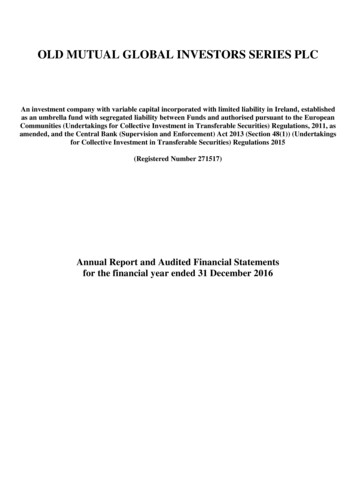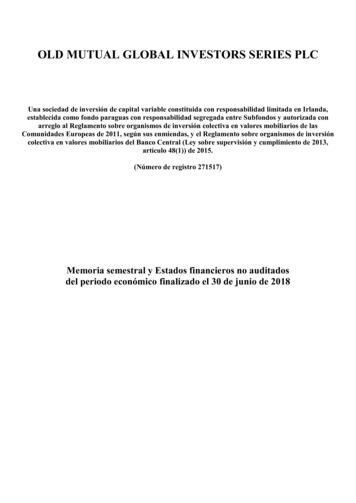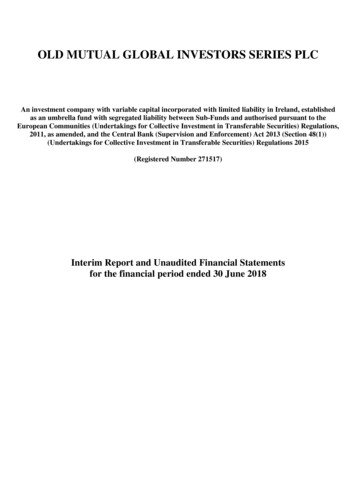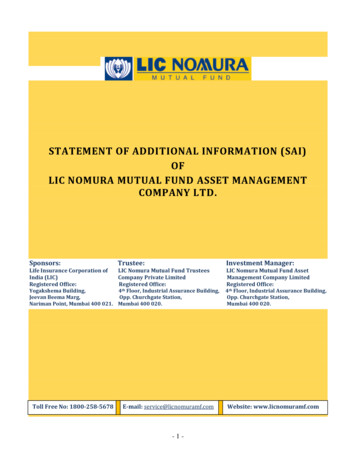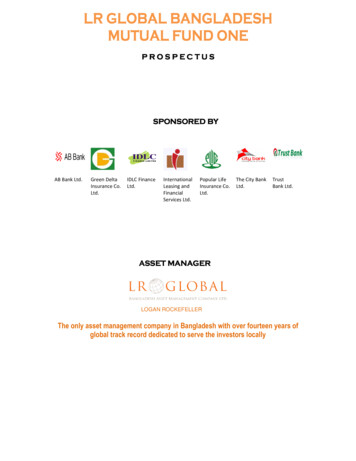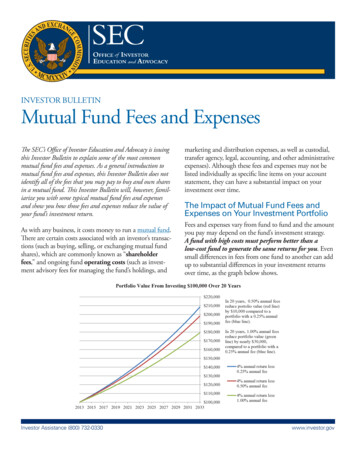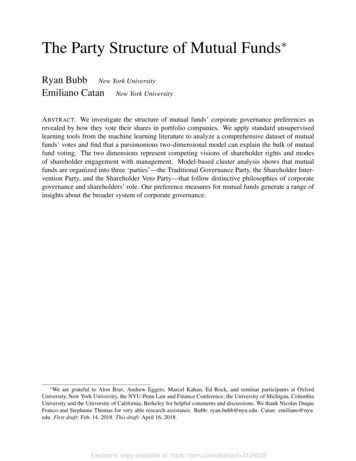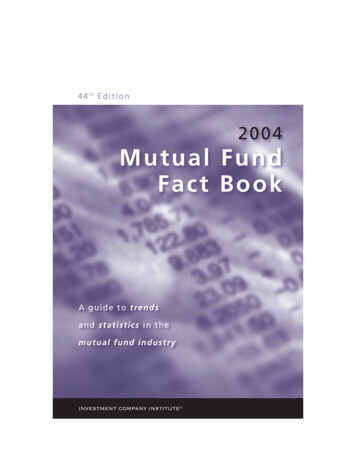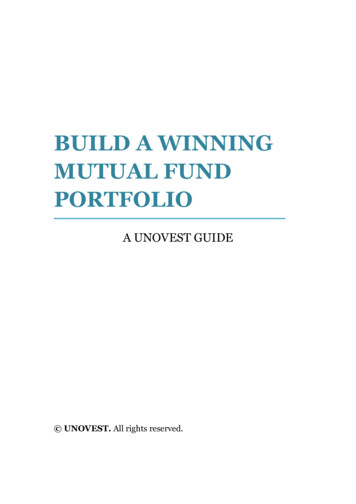
Transcription
BUILD A WINNINGMUTUAL FUNDPORTFOLIOA UNOVEST GUIDE UNOVEST. All rights reserved.
BUILD A WINNING MUTUAL FUND PORTFOLIOIntroductionThere are more than 500 mutual fund schemes in India offered by44 fund houses (as of Sept 2017). These fund schemes come in awide variety of options, investment styles and investmentobjectives.In fact, the total number of mutual fund options, you have tochoose from, turn out to be more than 3000 (not counting directand regular plans).It's baffling.How do you go about choosing the best ones for yourportfolio that will help you meet your goals?How do ensure that you don’t make grave mistakes inyour selection and rather pick schemes that will take careof your money as their own?How do you choose those funds which do not take unduerisk and yet generate an adequate inflation beatingreturn to help you build your wealth to meet goals?Given the wide choice, many well-meaning organisations andindividuals have come up with ways to help you select the bestmutual funds that channelise your savings, which can grow them ata reasonable risk.This help comes in the form of ratings, rankings and opinions.Unfortunately, none of them makes your job to select mutual fundsabsolutely easy. At best, they act as first level filters. You still haveto make choices from the reduced list of options.What to do?Which funds should you pick?WWW.UNOVEST.CO2
BUILD A WINNING MUTUAL FUND PORTFOLIOHow do you build a decent portfolio that puts your money to workwhile you focus on what you are good at – your work and growingyour income?These are the questions that this eBook seeks to answer.With this eBook, you will:1. Understand how NOT to select a mutual fund2. Learn to work with key factors to consider in mutual fundselection3. List the criteria for your own fund selection4. Build your own portfolio of equity mutual funds (by applyingadditional criteria)5. Create an asset allocation with mutual funds6. Avoid the key mistakes in building a mutual fund portfolio7. Know when to sell a mutual fund (or book profits)Bonus: 20 point checklist to know if a mutual fund scheme shouldbe a part of your portfolioIf you have any feedback or comment that you would like to shareabout this eBook, feel free to write to me at vipin@unovest.co.All the best for building your own winning mutual fund portfolio!Your friend @UnovestVipin KhandelwalWWW.UNOVEST.CO3
BUILD A WINNING MUTUAL FUND PORTFOLIODisclaimerAll information in this eBook is for education and informationpurpose only. It is to help you become a better investor. Thenames of the funds mentioned in this eBook are used as examplesfor better understanding. None of the information in thisdocument should be considered as an investment advice. Pleaseread the terms of use of the Unovest website.WWW.UNOVEST.CO4
BUILD A WINNING MUTUAL FUND PORTFOLIOIndex1. How not to select mutual funds .62. What to look for in a mutual fund scheme .123. Setting the mutual fund portfolio criteria .184. Let’s build an actual mutual fund portfolio 215. Asset Allocation with Mutual Funds .276. When should you book profits in mutual funds?.327. Build your wealth and meet your goals with Unovest’sMutual Fund Portfolios 38BONUS DOWNLOAD: 20-point MF Investing Checklist .45WWW.UNOVEST.CO5
BUILD A WINNING MUTUAL FUND PORTFOLIO#1How NOT to select amutual fund?WWW.UNOVEST.CO6
BUILD A WINNING MUTUAL FUND PORTFOLIOWhile there is a ton of advice on how to select mutual funds andhow to build a portfolio, there is very little on how NOT to.So, let’s invert the ‘selection’ process and understand how do weNOT select mutual funds.Finding a good mutual fund scheme relevant to your needs is likefinding a needle in a haystack.You start to apply various filters and shortcuts to find theseneedles in a haystack, to select mutual funds that you should investin.Due to lack of time, effort and inclination, you pick and chooseyour funds using easy, convenient and obvious indicators such as:1. Star Ratings – Typically 4 to 5 star rated funds2. Past Returns – Funds with higher 3 to 5 year returnsshould be better than the rest3. Brand – a popular, well-known brand4. Friends, Colleagues, Popular media – You feel you cantrust them.Let us understand each of them - one by one.#1 Star RatingsStar Ratings is an idea that we use in almost every aspect of ourlives for evaluating hotels, restaurants, business services, websites,advisors, etc. Everything has a star rating.WWW.UNOVEST.CO7
BUILD A WINNING MUTUAL FUND PORTFOLIOThe star ratings just make it easier for us to decide. I mean howelse do you find out whether to put your money for thatproduct/service or not. It is convenient to rely on existing userexperiences, which reflect in the ratings.Now, when it comes to mutual funds, you would prefer to investin a 4 or 5 star rated fund. You believe it to be the best. Right?Not really. There is a big problem with star ratings ofmutual funds.First, these star ratings do not reflect user experiences like theydo for hotels or e-commerce sites. They are created based on acomplex methodology using past returns and risk and is developedby the rating organisations.Second, mutual funds are not able to maintain their ratings overtime. If you track the ratings over 1 or 3 or 5 years of variousmutual funds, you would see that the ratings change almost everyyear.Since they are based on quantitative factors only such as risk andreturn, as the numbers change, the ratings change too. It is not besurprising to see a 5 star rated fund being down rated to 3 starsand vice versa.If you go to any of the rating portals, like Value Research orMorning Star, you can track the ratings of the fund schemes andsee how these ratings change for the funds that you are invested inor want to invest in.You invest in a 5-star rated fund only to find that nextyear it has gone to 3 stars.Let’s see what it does to your investment.WWW.UNOVEST.CO8
BUILD A WINNING MUTUAL FUND PORTFOLIOWhen you select mutual funds and invest on the basis of starratings, you would have to keep selling and buying mutual funds asand when the ratings change.This means you have to incur taxes related to buying and selling. Italso means that you need to invest time and effort to keep track ofchanges in ratings or pay fees to an advisor to do the same for you.If you don’t exit your lower star rated funds and just keep buyingthe new 5-stars, you are soon going to have an ugly, bloatedportfolio with several schemes.Investing on the basis of star ratings ONLY is definitelyNOT a good idea. The pioneer of Mutual Funds rating companyas also the biggest, Morning Star, says that too.#2 Past ReturnsWhat is the standard disclaimer you find on any mutual fundfactsheet or advertisement?“Past performance is no guarantee of future returns. Pleaseread the offer documents carefully before investing.”This is not just a disclaimer. It is a fact. Yet, when we set out to buymutual funds, the first thing that we look at is ‘past returns‘. Iwould argue that you should NEVER look ONLY at returns toselect mutual funds.In my humble opinion, an investment decision purely on the basisof returns is a big mistake.You see, relying solely on performance can do more harm thangood to your portfolio. You will churn your portfolio too much andit is quite likely that you will enter a new high flying fund only afterit has run out of steam.WWW.UNOVEST.CO9
BUILD A WINNING MUTUAL FUND PORTFOLIOYou are probably aware about the law of mean reversion. Anyperiod of superior performance is likely to be followed by a periodof lower performance. Overall, over long period of time the returnstend to move towards the average or meanRather, you must focus on how the fund goes about managing theportfolio. You cannot control returns. At best, you can trust theprocess.#3 Brand NameA BRAND is a mental shortcut to familiarity and trust. It is not justtrue for mutual funds but almost anything. Ask any fresher MBAtoday about where she would want to work and the instant answeris “with a big brand”.Now, money is a very sensitive subject. You would not want tohand over your hard earned money in the custody of someone youcannot trust. A popular, well-known brand, thus, acts as anaffirmation of the trust.A good brand name, however, is no guarantee that it is goodfor your money too. Let me bring forth some facts.A lot of existing fund houses in India have been working under theumbrella brands of their parent organisations and riding on thetrust that the parent enjoys. Take for example, an HDFC, Tata,Birla, etc.Yet, the brands have committed big mistakes.They have launched multiple schemes to amass large funds, all inthe name of marketing. The larger the number of schemes, themessier it becomes for an investor to pick the relevant ones.WWW.UNOVEST.CO10
BUILD A WINNING MUTUAL FUND PORTFOLIOThe bottom line is, a well-known brand is good but not necessarilyfor your portfolio too.#4 Friends & familyA simple example will suffice here.I remember a gentleman ran a poll on a popular Facebookforum, as to which top 2 or 3 equity mutual funds do the groupmembers invest in? As the replies started to come in, you couldfind almost every mutual fund name out there.As the popular Hindi saying goes, jitney muh, utni baatein.Jitne log, utne fund schemes.I rest my case.You are better off ignoring the noise generated by the aboveparameters / filters and focus on what really matters.Let’s move to the next section.WWW.UNOVEST.CO11
BUILD A WINNING MUTUAL FUND PORTFOLIO#2What to look for in amutual fund scheme?WWW.UNOVEST.CO12
BUILD A WINNING MUTUAL FUND PORTFOLIOLet’s now look at what truly matters in fund selection.A mutual fund has several features and it is important tounderstand them to make a proper selection.Understanding the details of a scheme enables you to take aperspective about that scheme and decide if it suits your goals.Here is an overview of the key items that you need to understandabout a mutual fund scheme.For reference, we will use Franklin India Bluechip Fund (FIBF)and its factsheet for July 2017.#1. Scheme ObjectiveThis is a brief summary of what the scheme intends to do.In case of FIBF it is “is an open end growth scheme with anobjective to primarily provide medium to long-term capitalappreciation.”Most scheme objectives tend to be vague and that’s where you canspot the difference. A clearly defined investment objective is a goodsignal.#2. BenchmarkThe fund scheme benchmarks its performance against a marketindex. The choice of the index benchmark helps understand whatkind of a stock selection strategy a scheme is likely to follow.The benchmark for FIBF is S&P BSE Sensex. BSE Sensexconsists of some of the largest companies as per marketcapitalisation in the Indian stock market. This further affirms theidea that the fund is likely to invest in large cap ‘bluechip’ stocks.WWW.UNOVEST.CO13
BUILD A WINNING MUTUAL FUND PORTFOLIO#3. Fund ManagerWhile most fund houses profess to be governed by processes andnot by individual whims, fund managers do tend to influence theinvestment style of a fund. It is not easy to discount the fundmanager experience. It does matter.A good fund manager helps create a strategy that can deliver betterrisk-adjusted returns for the fund scheme.However, a fund that delivers only because of the presence of aparticular fund manager is unlikely to sustain its performance inthe long term.FIBF’s current fund managers are Anand Radhakrishnan(managing the fund since June 2013) and Roshi Jain.#4. Investment StyleThe investment style is a sneak peek into fund’s investmentuniverse and the process of stock selection.It may also specify the maximum number of stock the fund willhave in the portfolio and the allocation range for a stock. Thisdefines the diversification strategy of the scheme.FIBF investment style statement says, “The fund manager seekssteady and consistent growth by focusing on well established,large size companies.”You can find more details about the investment style in the SchemeInformation Document (SID).#5. Portfolio holdings (stocks/sectors)The current holdings of the fund in terms of stocks and sectors giveyou an idea of where the fund is invested and whether it is in linewith the objective and style it has identified for itself.WWW.UNOVEST.CO14
BUILD A WINNING MUTUAL FUND PORTFOLIOYou may see Top 10 stocks and sectors in some cases, while otherfund factsheets present the entire portfolio.FIBF has 43 stocks in its portfolio – which means that the portfoliois quite diversified indicating an average of about 2.5% per stock.However, 9 stocks in the portfolio have an allocation higher thanthe average.#6. TurnoverThe turnover of the portfolio suggests how often the fund makeschanges to its portfolio in terms of buying and sellingstocks/securities.As a general rule, the lesser it is, the better. Higher turnover meansmore churning, more expenses, which can drag down returns.FIBF’s turnover, as per the July 2017 fact sheet is, 36.45%. Thatmeans that on an average an investment in a stock stays for about3 years in the portfolio.Remember this is standalone number as of July 2017. You need tounderstand the trend. For example, a few months ago, the fundhad a turnover of just 17%. So, is this just one off number or thefund is using more churn in its portfolio?#7. Past performanceFor most investors, past performance is the holy grail of fundselection and that too point-to-point returns for lump suminvestment amount. This is highly misleading.They make their investment decisions based on this one factor.This may not be correct. At least, past performance and point-topoint returns is not the only thing that one should look at.WWW.UNOVEST.CO15
BUILD A WINNING MUTUAL FUND PORTFOLIORolling returns provide a much better idea of a fund performancesince they look at performance across time periods more like atrend.Along with it, portfolio strategy and various other ratios deservemore attention than just past performance.Volatility and Risk adjusted return measuresThese measures pertain to ratios such as Standard Deviation andSharpe Ratio. These measures could again be different numbersdepending upon where you are looking. Different time periods canproduce different results.In case of FIBF, data over a period of 3 years has been used forthe calculation.#8. Standard DeviationStandard deviation tells you how much of a yo-yo the fund’s valuetends to be against its average. Higher the standard deviation,more volatile the fund is.FIBF has a standard deviation of 3.66%, which means that it is lessvolatile.#9. Sharpe RatioThe Sharpe Ratio is a measure of how much additional return thefund has delivered for every additional unit of risk taken.It is calculated as (% Return of the fund – % Risk free rate of return*) / StandardDeviationIn case of FIBF, the Sharpe Ratio is 0.61.*Risk free rate is, for example, the 10 year Government Bond rate.WWW.UNOVEST.CO16
BUILD A WINNING MUTUAL FUND PORTFOLIOMost of these ratios are better understood when compared withpeers or over a time period as trends.#10. Expense RatioThe expense ratio is the fee charged for running the show. It is asum of all expenses that the fund charges including Investmentmanagement fee (plus GST), sales and distribution costs includingcommissions, brokerages, custodian charges, etc.In case of FIBF, it has an expense ratio of 2.23% for its regular planwhile the expense ratio of direct plan is 1.36%.Direct plan expenses are always lower because they do not havecommission costs to pay.-As an investor, it is quite likely that you feel overwhelmed with thisinformation. Anyone would be.However, you can build a considerable advantage by learning tolook at these parameters.Start with the fund factsheet and then you can go deeper with theScheme Information Document. Use it to ask more questions of afund.Know and understand your fund in advance before youmake your investment. It will prevent a lot of heartburnlater.WWW.UNOVEST.CO17
BUILD A WINNING MUTUAL FUND PORTFOLIO#3Setting the portfolioselection criteriaWWW.UNOVEST.CO18
BUILD A WINNING MUTUAL FUND PORTFOLIONow that we understand what’s important about a mutual fundand you have gone through a few fund factsheets, you may want torush and pick funds for your portfolio.That’s what Ajay wanted to do too. I had to literally hold him by hishand.“Not so fast! Wait!”As you know, there are thousands of mutual fund schemes. Let’sfirst identify what are the criteria that will work for you to shortlistschemes and to build your unique equity mutual fund portfolio.Now, given the hundreds of schemes under consideration, we canuse some simpler filters to remove most of them. No Sectoral/Thematic funds: As far as possible, stickwith diversified funds which can invest across sectors andnot restrict themselves to a particualr theme. Hence, skip thesectoral/thematic variety such as those focused on Pharma,Exports, Logistics, etc. There is no point restricting the scopeof the fund in finding opportunities. Index Funds: Unless you are an investor who does NOTbelieve in active fund management, index funds are not foryou. Fortunately or unfortunately, in India, the activelymanaged funds have still some way to go. No Closed ended funds: Closed ended funds are openonly for a limited initial period for buying. You are locked induring your investment period and cannot make changes.Hence, they can be excluded too.Now, let’s list down what to pay attention to. On the specificfund scheme level, here are the things to be considered.WWW.UNOVEST.CO19
BUILD A WINNING MUTUAL FUND PORTFOLIO Fund age: Typically, consider funds with more than 5 yearsof existence. However, entities that have a cumulativeorganisation experience of over 5 years in fund or investmentmanagement can also be shortlisted. Fund Size: A good criterion would be to have funds with atleast Rs. 100 crore of AUM. However, we cannot let a goodfund pass just for this one criterion. Expense* Ratio: Expense is the only thing that you cancontrol. Aim to go for funds that are not very expensive butdeliver the right value for what they charge. Even better wayto look at this is to see the trend of the expense line. A goodfund will work to reduce its expense ratio as it grows. Fundhouses like Quantum, PPFAS, Franklin India etc. have shownthis trend. Turnover Ratio: A consistently high turnover ratio is a redflag too. With equity funds, the turnover ratio should be notmore than 30% to 40%.*Direct plans also ensure that your expense ratio remains on thelower side. In debt funds, a higher expense ratio can wipe off anyadvantage that you came looking for.As you would notice, past performance is not one of thefilters here. You already know why.Use these factors to download a filtered list of funds from one ofthe online aggregator sites or from Unovest.The funds that we select should have a well defined investmentmandate and a laser sharp execution focus. Let’s now go on tobuild an actual mutual fund portfolio.WWW.UNOVEST.CO20
BUILD A WINNING MUTUAL FUND PORTFOLIO#4Let’s build an actualmutual fund portfolioWWW.UNOVEST.CO21
BUILD A WINNING MUTUAL FUND PORTFOLIOWhen Ajay approached me for his mutual fund portfolio, hementioned that he wants to invest for his retirement, which isabout 20 years away.He has a moderate to aggressive risk profile. At Unovest, amoderate risk taker is recommended to have upto 60% allocationto equity (via stocks or equity mutual funds). Ajay can afford to be60% but then his asset allocation and his need will decide that.The question on Ajay’s mind is which schemes should he selecttowards his retirement.He has gone through the previous notes on fund selection andagrees with the process.He wants to include those funds which will deliver a better riskadjusted return over a long period of time.After studying and applying the criteria discussed so far, he cameup with his first shortlist.WWW.UNOVEST.CO22
BUILD A WINNING MUTUAL FUND PORTFOLIOAjay’s Shortlist of Mutual FundsThis is quite a huge list of funds, close to 20.Ajay realises that while most of these funds are great performerswith brilliant history of management, he can’t have all of them. Heneeds only 4 to 5 funds to build a diversified portfolio for hisretirement.The question now is which of the above should beincluded and which ones to be excluded?It’s a difficult choice. The funds have differentiated strategieswhich they have been executing on relentlessly.WWW.UNOVEST.CO23
BUILD A WINNING MUTUAL FUND PORTFOLIOSo, Ajay lists a few additional guidelines towards limiting hischoices and building a portfolio. They are:1. No more than 5 funds in the portfolio and give themadequate weightage to be able to move the needleand make a difference.2. Preference for flexicap/multicap funds since they canmove around the entire spectrum of capitalisation and not belimited to large cap, mid caps or small caps. Predominantlylarge cap funds can be considered.3. No pure large cap funds, since most flexicap / multicapfunds already have a significant portion in large cap stocks.4. More of mid and small cap funds to add that extra riskelement. A good fund with a focused mandate in that spacecan boost the overall portfolio returns.5. Focus on the cost element that is expense ratio. He wouldprefer funds which have a history of reducing their expensesas AUMs grow.6. Focus on “buy and hold” funds. This can be measured by alow turnover ratio – typically not more than 40% andshould be reflected in the trend.The above itself will not be sufficient to bring down the list numberto 4 or 5. Hence, Ajay has decided to apply one more criteria.The AMC should have a clear focus on fundmanagement and be a standalone professional fundhouse with ‘skin in the game’.The Skin in the game means that the fund managers should haveinvested their own money into the funds. It is a simple heurestic –does the cook eat his own cooking?WWW.UNOVEST.CO24
BUILD A WINNING MUTUAL FUND PORTFOLIOAjay’s Final List of mutual fundsWith these criteria applied, Ajay was able to zero down on thefollowing funds1. Franklin India Prima Plus Fund – Flexi cap fund2. Parag Parikh Long Term Value Fund – Flexi cap fund3. Quantum Long term Equity Fund – A predominantlylarge cap fund4. Mirae Asset Emerging Bluechip Fund – A mid cap fundAjay was conflicted for choice between Franklin Smaller Cos,Sundaram Select Midcap and Mirae Asset Emerging Bluechip.However, he decided not to have more than 1 fund from the samefund house. Mirae also stood out as a stand alone professional fundhouse compared to Sundaram.Finally, Ajay had a portfolio that catered to his own criteria andrequirements.How can this portfolio turn out to be different forsomeone else?Let’s build a different portfolio, for you.Suppose you are willing to take a much more aggressive approachtowards your portfolio. You want to include more mid caps as wellas run a concentrated portfolio with fewer holdings.In that case, from Ajay’s shortlist, your portfolio could includefunds such as:1. MOST Focused Multicap 35 Fund2. Parag Parikh Long Term Value Fund3. Sundaram Select Midcap Fund / Franklin India SmallerCompanies FundWWW.UNOVEST.CO25
BUILD A WINNING MUTUAL FUND PORTFOLIOIf you are an NRI, specially a US/Canada based NRI, thenyour choices are further restricted by the AMCs that acceptinvestments from such NRIs.Assuming you are a moderate risk taker, your portfolio couldinclude funds such as1. Parag Parikh Long Term Value Fund2. Sundaram Select Midcap Fund3. L&T India Value FundRemember – to each, his own.That’s what a customised portfolio relevant to your needs, riskappetite and time horizon is about.So, what will your portfolio look like?WWW.UNOVEST.CO26
BUILD A WINNING MUTUAL FUND PORTFOLIO#5Asset allocation withmutual fundsWWW.UNOVEST.CO27
BUILD A WINNING MUTUAL FUND PORTFOLIOAsset Allocation is one of the finest diversification mechanisms. Itis the method to how should you divide your money betweenvarious asset categories or classes such as equity, bonds, realestate, gold and cash.Your financial goals, time horizon and risk tolerance play a role indeciding this allocation.For example, after considering all the factors mentioned,suppose you decide to have the following asset allocation for yourportfolio:What if I tell you that there is a mutual fund for all of theseoptions.Imagine the range, convenience and flexibility of mutual funds toexecute your own portfolio asset allocation.For Equity, you can choose equity mutual funds as the investmentvehicle.For Bonds, in India there are many options that investorsexercise, including EPF, PPF, Corporate Deposits, Postal Schemes,Fixed Deposits, etc.Debt mutual funds too can be used to make any requiredallocation towards bonds. Debt funds or Bond funds are also moretax efficient, specially for high tax bracket individuals.Real Estate can be allocated with REITs or Real EstateInvestment Trusts. We will see REITs very soon in India too.WWW.UNOVEST.CO28
BUILD A WINNING MUTUAL FUND PORTFOLIOGold Mutual Funds which invest in actual physical gold can beused to allocate towards Gold. E.g. Quantum Gold FundWith mutual funds, you can own Gold and Real Estatewithout the pains and the costs of holding a physicalasset.Rebalancing the asset allocation becomes a fairly simpleexercise too.If you have to sell a part of the Real Estate to invest inbonds/equity, you can always sell a portion of the REIT to get yourasset allocation in order.or the purpose of this eBook, let’s spend some more time on howto select debt mutual funds for your portfolio.How to select Debt Mutual FundsSelecting debt mutual funds is tougher than selecting equity funds.Yes, this statement is difficult to believe, but it is a fact.The variety and the individual investment styles varying throughcredit quality and time horizon is so large in debt funds, that youcan easily get lost.To first understand debt funds, you need to know that debt fundsinvest in corporate debt and government securities.There are 2 key risk parameters.One, the credit quality or how likely is the borrowing party likelyto honour its payment and not default. Government securities areassumed to be the highest quality as the chances of default are nil.WWW.UNOVEST.CO29
BUILD A WINNING MUTUAL FUND PORTFOLIOTwo, what is the time horizon for which the investment is beingmade? With longer duration, more market risk enters the portfolio.Debt funds are sensitive to change in interest rates and thissensitivity goes up as the duration goes up.Having taken these into account, we can rely on a few filters toidentify the right funds for our portfolio.Here is what I use to shortlist the debt funds:1. Age: Consider schemes that have been in existence for atleast 3 years.2. Size: Schemes should have more than Rs. 100 crores ofAsset under Management.3. Focus on diversified schemes. Exclude Gilt funds or aBanking & Financial Services funds and a PSU Sector focusedfund.4. Cost is an important factor when it comes to debt funds. Ifyou have to choose between two similar funds, choose theone with the lower cost. Also, choose direct plans. I observedthat the expense ratios of direct plans were almost half ofthose of the regular plans (on account of savings incommissions).5. Credit Profile: Debt funds invest in credit instruments ofother companies and/or the government. To maintain therisk profile, the credit quality of the portfolio is importanttoo. Hence, funds with High and Medium Credit qualityholdings have been included in the list. This credit quality istypically measured with the credit rating such as AAA, AA,A , BB, BB-, etc.6. Sensitivity to interest rates: Finally, pay attention toDuration (measure of the sensitivity of the portfolio tochange in interest rates) and Average Maturity of the fundWWW.UNOVEST.CO30
BUILD A WINNING MUTUAL FUND PORTFOLIOportfolio. A thumb rule is that you should choose a fund thathas a Duration less than your investment time horizon.Most of the above information is available in factsheets as well asonline portals.Along with that background, you can rely on the followingcategories to make your final selection. Liquid funds – For time horizon of upto 6 months. E.g.Quantum Liquid Fund Ultra Short term funds – For time horizon of 6 months to2 years. E.g. UTI Treasury Advantage Fund Short term funds – For time horizon of 2 to 3 years. E.g.Franklin India Short Term Income Plan Income funds (includes dynamic bond funds) – For timehorizon of greater than 3 years. E.g. HDFC Income FundThe liquid, ultra short term and some short term funds follow anaccrual strategy where in they work towards a steady increase inNAV without causing ups and down in the value.The mid and long term funds (including Gilt funds) tend to alsoengage in bringing capital gains by more active management of theportfolio. This makes them more volatile too.Here’s the journey of Rs. 10,000 when invested in various debtfunds. See for yourself.WWW.UNOVEST.CO31
BUILD A WINNING MUTUAL FUND PORTFOLIO#6Profit booking inmutual funds – Wiseor Foolish?WWW.UNOVEST.CO32
BUILD A WINNING MUTUAL FUND PORTFOLIO“I am thinking of booking profits in my mutual fund portfolio”,Vivek mentioned casually. I looked up and asked him, “OK. Whydo you want to do that?”“You see the markets have run up so high and the value of myfunds has also gone up by about 30% to 40%. I should book theprofits before I lose them all to a market fall.”I smiled at my friend’s rhyming logic of profit booking. Now, hewas right in one sense but completely wrong in another. How?Let’s understand it step by step.What is profit booking?Profit booking simply means that you convert your unrealisedpaper profits into cash. Without this conversion, the gains or theprofits don’t mean anything.For example, 1 year ago you bought stock of Company A at Rs. 100.Now the current market price
BUILD A WINNING MUTUAL FUND PORTFOLIO WWW.UNOVEST.CO 2 Introduction There are more than 500 mutual fund schemes in India offered by 44 fund houses (as of Sept 2017). These fund schemes come in a wide variety of options, investment styles and investment objectives. In fact, the total number of mutual fund options, you have to
